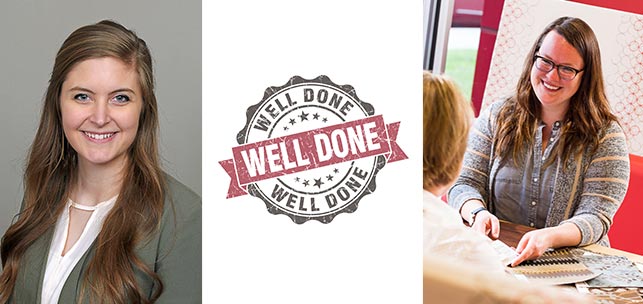Interior design is embedded within the architectural discipline at TSP, right where space planning and artistic functionality meet. The practice is an integrated service in our full-scale projects, and it’s a crucial part of what makes rooms and entire facilities “just work” for clients.
Certain designers elevate that practice to a profession. This week, two TSP team members learned they’d passed their final exams to be recognized by the National Council on Interior Design Qualifications. Caroline Johnson and Brenna Wiertzema now are certified for their expertise, which means TSP’s entire interior design staff is nationally credentialed.
“I originally was studying art and psychology, and I took an environmental psychology course,” says Wiertzema, who changed her focus to interiors not long after and works in TSP’s Sioux Falls office. “I was amazed by how much our environments affect us–how they help us thrive, or not. This is really the culmination of that. It’s all about creating a healthy, safe place for people to do their best.”
The NCIDQ’s three, separate test sections cover seven distinct areas that capture core competencies: building systems, codes, construction standards, construction administration, design application, professional practice, and project coordination. The exams are offered only twice a year, and candidates must complete the entire cycle in five years. The clock starts ticking with the first test date.
Wiertzema earned her degree from South Dakota State University, while Johnson graduated from the University of Nebraska-Lincoln. Neither state has a process in place to register interior designers at that level. But Johnson now practices in TSP’s Rochester, Minn., office — which means she can become licensed as a Certified Interior Designer (CID) with the board responsible for overseeing architecture, engineering, surveying, and interior design professions.
“One of my professors was very gung-ho about it, no matter what state we were studying in or planned to work in,” Johnson says. “She told us this is educational, it’s more great information to know in your work, and having those letters behind your name means something. … We do so much more than choose paint colors and pillows, and I think there’s still a bit of a stereotype about that.”
Wiertzema also set a personal goal to pursue national certification, despite no requirement in South Dakota that individuals pass the exams to market themselves as interior designers. She estimates more than half the designers she knows in South Dakota have not achieved NCIDQ certification and don’t intend to do so. The national designation is an extra mark of credibility that attests to an individual’s scope of knowledge. It’s a reassurance for clients as well as the firms entrusted with their projects.
“The focus really is on competency, life safety, and the health and welfare of any building occupant,” Wiertzema says. “We’re tested on building codes, egress paths and corridors, exit signs, smoke detectors, and fire-rated construction. Honestly, I wasn’t aware so much of that would be involved until I started studying. It’s in-depth, overall building safety, and we’re responsible for that alongside the architects and engineers for the way we design those spaces.”

